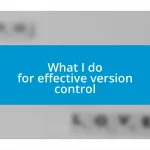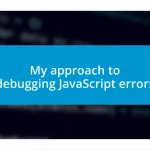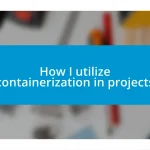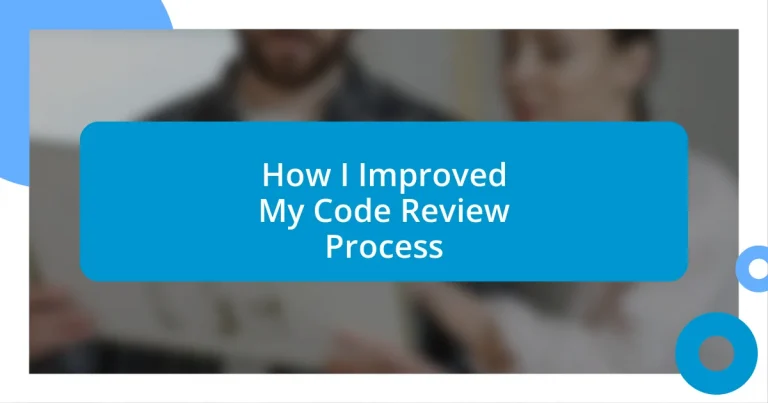Key takeaways:
- Adopting a fresh perspective when reviewing code leads to better detection of issues, improving overall quality.
- Establishing clear review goals and guidelines fosters effective communication and enhances team collaboration.
- Regularly gathering and analyzing feedback on the review process promotes continuous improvement and accountability among team members.
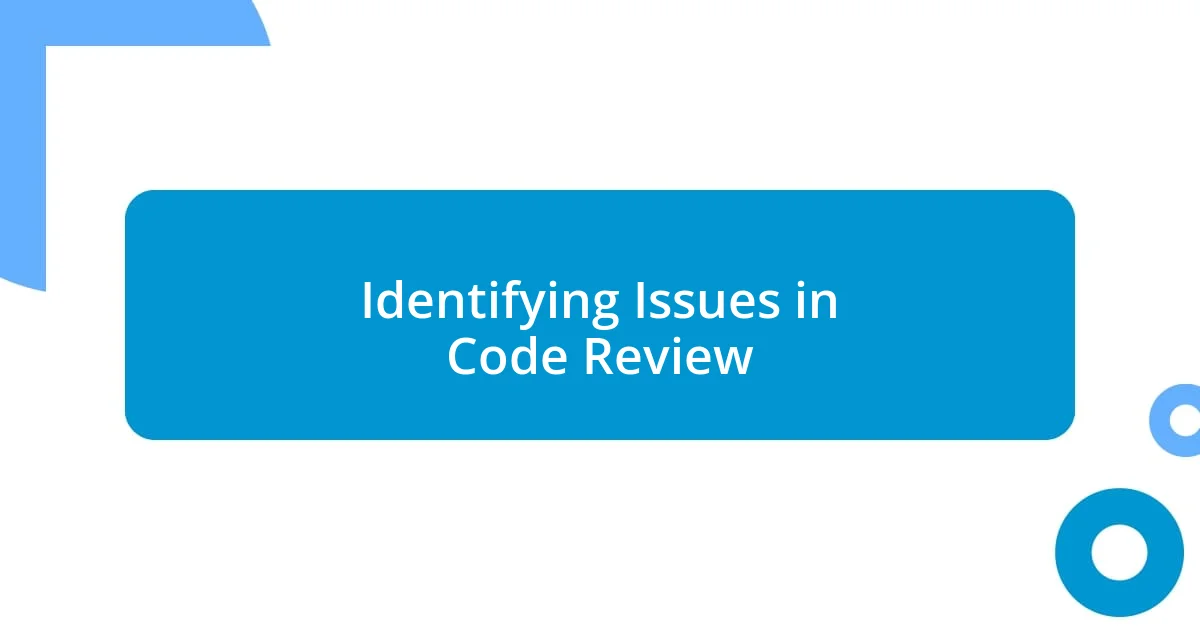
Identifying Issues in Code Review
Identifying issues in code review can often feel daunting. I remember a specific instance when I overlooked a simple typo during a review, only to have it cause a significant bug down the line. It made me realize how crucial it is to stay attentive to even the smallest details during reviews.
One effective strategy I’ve adopted is to approach code with a fresh pair of eyes. Have you ever gone back to a piece of your own work after some time and noticed glaring mistakes? That’s the magic of distance. By allowing a brief pause before reviewing, I can catch discrepancies and design flaws that I would otherwise miss in the heat of the moment.
Understanding the common pitfalls also helps in pinpointing issues early on. For example, I often encounter developers who focus solely on functionality without considering code readability. I used to be guilty of that too! Now, I ask myself, “Would someone else understand this code?” This question has become a valuable benchmark in my review process, making discussions with my team more productive and insightful.
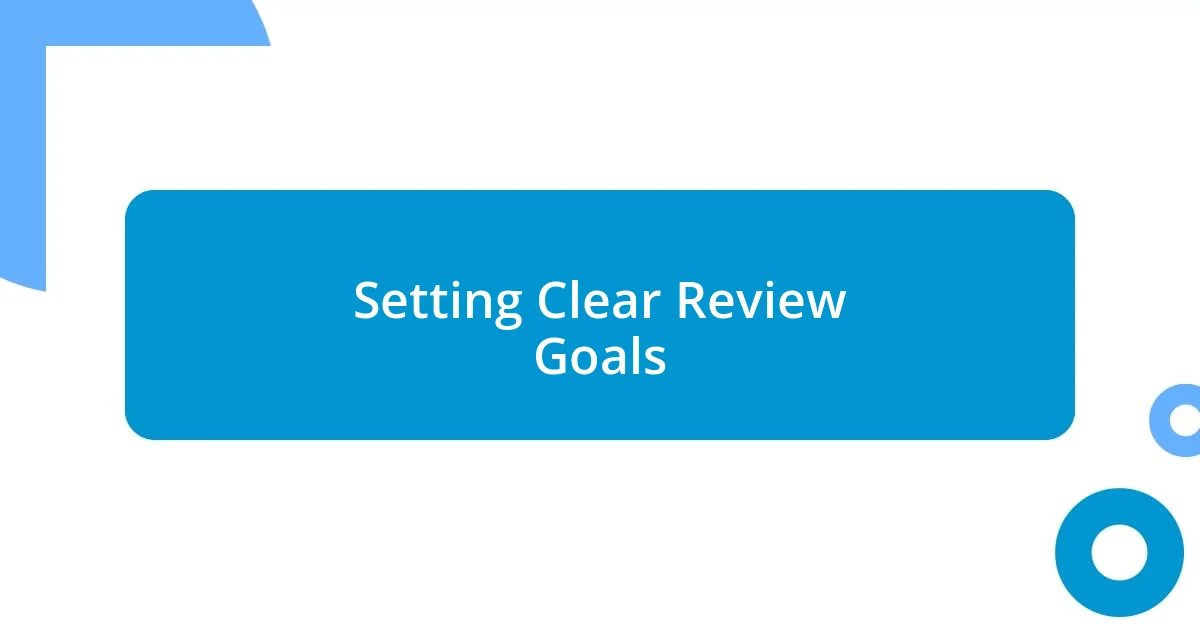
Setting Clear Review Goals
When I first started reviewing code, I often felt overwhelmed by the sheer volume of what needed to be checked. It wasn’t until I learned to set clear review goals that I found my footing. Each time I begin a review, I remind myself to focus on specific aspects, whether it’s optimization, error handling, or style consistency. This clarity shapes my thoughts and helps me stay organized.
Here’s what I typically focus on when setting review goals:
- Clarity: Ensuring the code is easy to read and understand.
- Functionality: Verifying that the code performs as intended.
- Best Practices: Confirming adherence to coding standards and conventions.
- Performance: Assessing whether the code is efficient and scalable.
- Testing: Checking for adequate unit tests or test coverage.
By being deliberate about my review goals, I’ve noticed I can engage more deeply with the code. I once set a goal around readability for a project, and that shift brought better discussions in my team meetings. I felt more confident in my reviews because I wasn’t just combing through lines of code; I was actively thinking about how those lines would impact my teammates and future maintainers. This thoughtful approach has significantly enhanced both my experience and the outcomes of the review process.
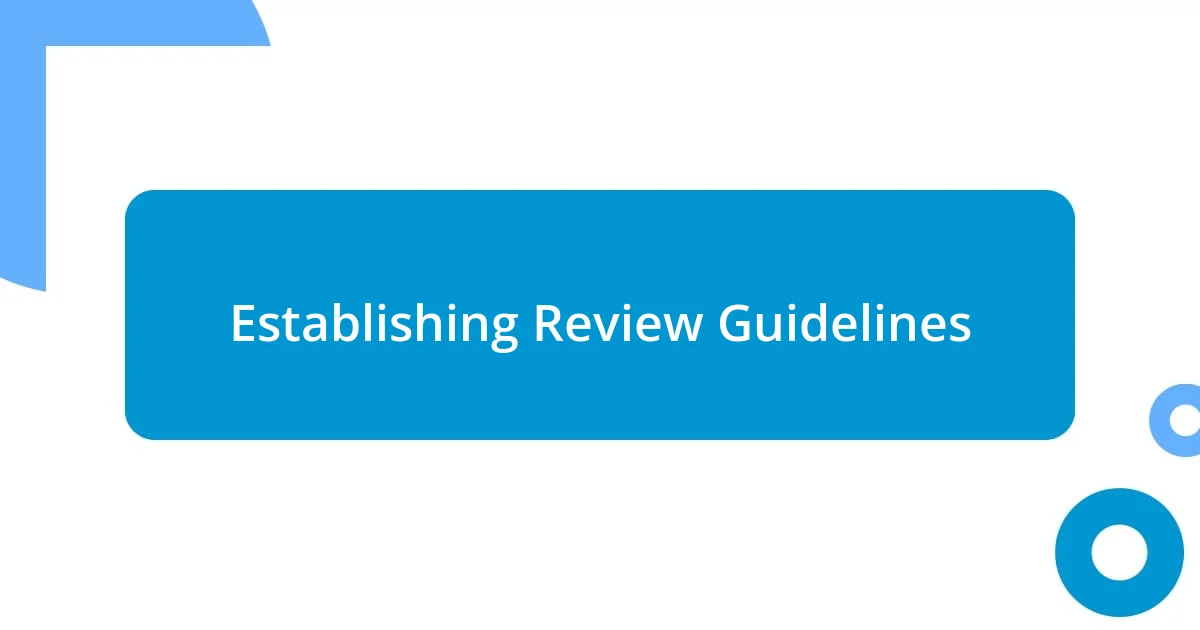
Establishing Review Guidelines
Establishing clear review guidelines has been a game-changer for me. Early in my career, I often found reviews to be chaotic—a mixture of comments, suggestions, and frustrations. By creating a checklist of guidelines, I’ve standardized my approach and provided my teammates with clarity. This consistency has not only improved my reviews but has also fostered a collaborative environment where everyone feels empowered to give and receive feedback.
One key aspect of my guidelines is to encourage constructive criticism. I remember a time when I received a review filled with vague comments, which left me feeling lost and demotivated. Now, I emphasize that my team focuses on specific, actionable feedback rather than general observations. For instance, instead of saying, “This part is unclear,” I guide them to say, “Could you explain how this works in the context of XYZ?” This seemingly small change has measurable impacts—team members feel more supported and are usually more receptive to feedback.
Moreover, I’ve learned the importance of prioritization in the review process. When establishing guidelines, I categorize feedback into critical, major, and minor issues. This approach has helped me communicate more effectively. One time, I spent hours on a minor stylistic choice that didn’t significantly impact functionality. Since incorporating prioritization, I’ve shifted my focus to what truly matters and, as a result, made reviews less stressful and far more productive.
| Guideline Category | Description |
|---|---|
| Constructive Feedback | Encouragement to provide specific, actionable comments. |
| Prioritization | Categorizing issues as critical, major, or minor for effective communication. |
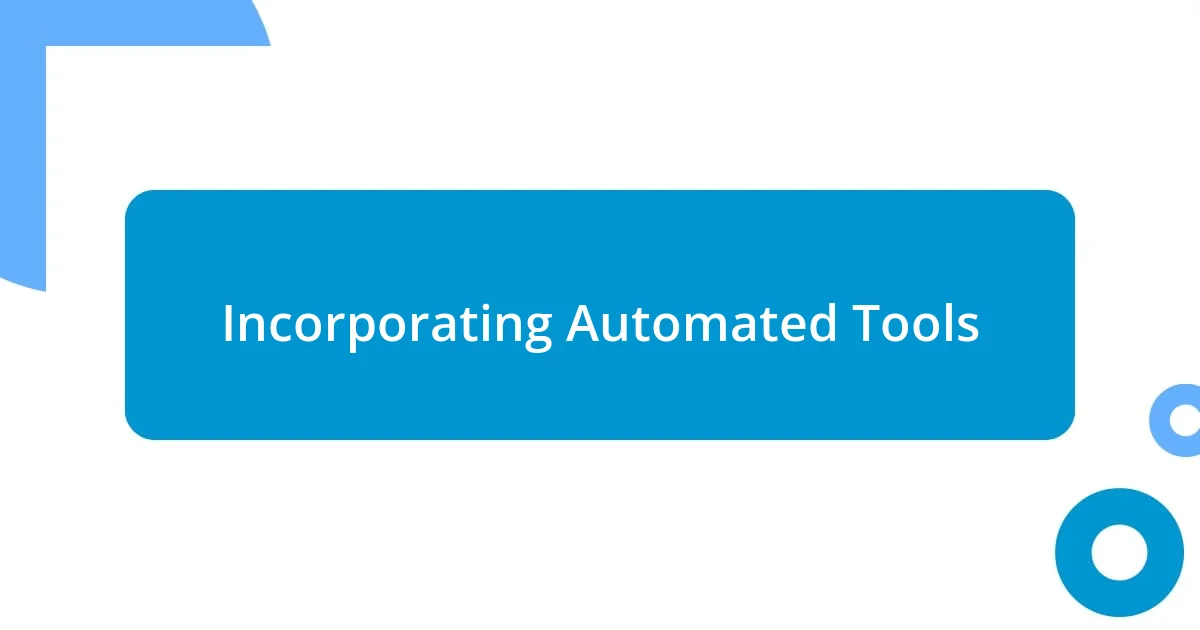
Incorporating Automated Tools
Incorporating automated tools into my code review process has been a revelation. Initially, I was skeptical, fearing these tools might make reviews impersonal. However, I quickly discovered that they actually enhance the human element. For example, I use static analysis tools that help catch common errors before my teammates even submit their code. It’s rewarding to see how much time this saves, allowing us to focus on more meaningful discussions.
One of my favorite tools examines code for style violations based on our team’s established guidelines. At first, I worried that it could dampen creativity. Yet, when a team member got feedback correcting a simple indentation issue, they joked, “Thank you, robot overlord!” That lighthearted moment reminded me that these tools can foster an environment where we all learn together. I genuinely appreciate how they help keep the codebase clean while giving developers a framework to work with.
Having these automated systems in place has transformed the way we engage in reviews. Instead of spending countless hours fixing trivial issues, I can dive deeper into the logic and design of the code. This shift not only enhances the quality of our output but also makes the entire process more enjoyable. I can’t help but ask myself: Isn’t it a win-win when technology helps us be more human in our approach?
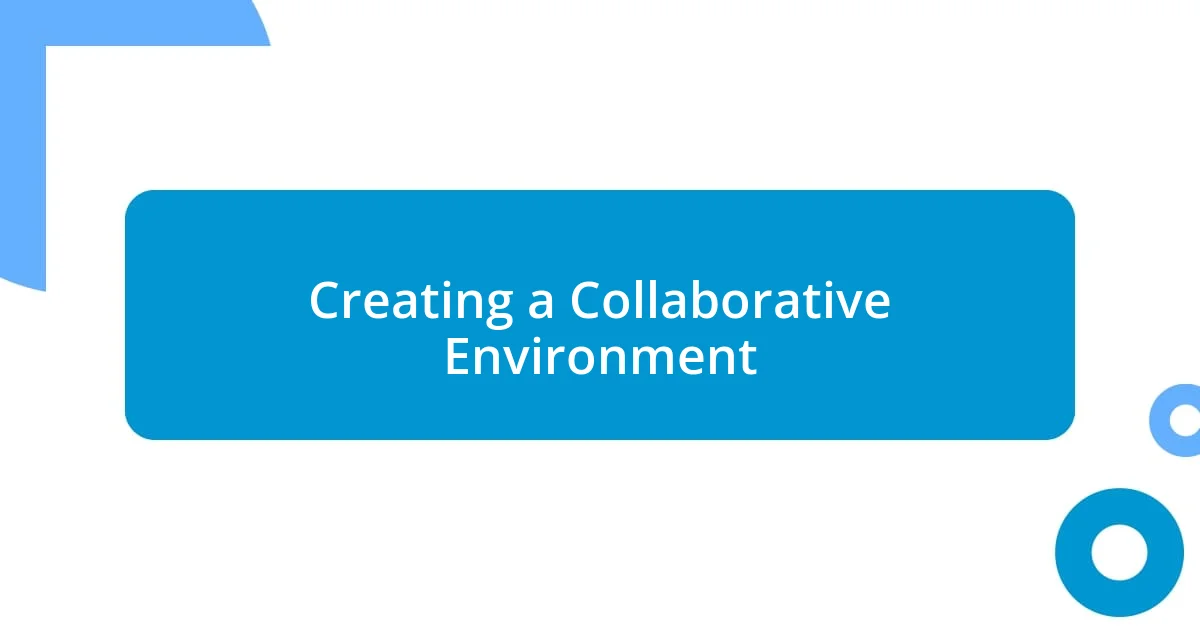
Creating a Collaborative Environment
Creating a collaborative environment in code reviews starts with building strong relationships among team members. I recall a time when I held informal coffee chats before a review session. These simple conversations broke down barriers and fostered trust, leading to more open and honest discussions during reviews. Have you ever noticed how a relaxed atmosphere encourages everyone to share their thoughts freely? It’s amazing how decreasing formalities can increase collaboration.
Equally important has been incorporating pair programming into our workflow. I remember my first experience with a partner—working side by side not only made the task at hand less daunting but also illuminated our thought processes. When we reviewed each other’s work together, it became less about critique and more about shared learning. Now, I try to regularly pair up with different team members, and it’s fascinating how it dissolves hesitation and elevates our collective knowledge.
Another pivotal strategy is celebrating our successes, both big and small, after reviews. I introduced a quick shout-out session at the end of each review meeting, where we all acknowledge contributions that stood out. I’ll never forget the beaming face of a teammate when their innovative solution received recognition. These moments reinforce the value of teamwork and make everyone feel more invested in our collaborative journey. How do you think celebrating achievements can influence your team’s dynamic? I believe it creates a sense of belonging that motivates us all to contribute actively.
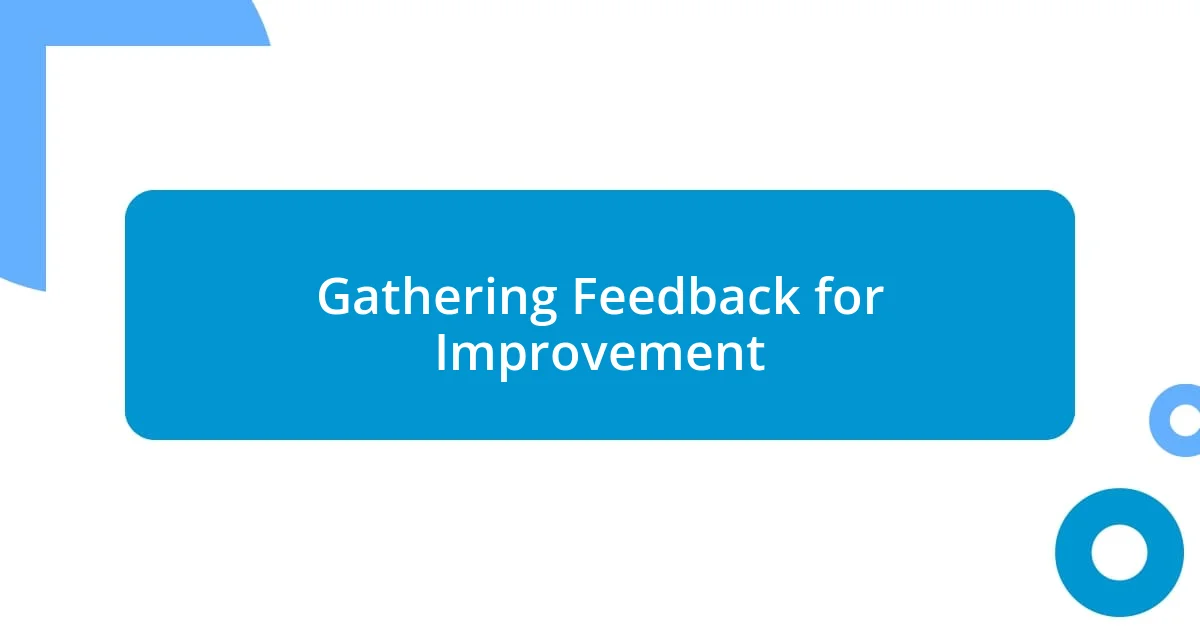
Gathering Feedback for Improvement
Gathering feedback is a vital aspect of improving any process, including code reviews. I remember when I first began soliciting feedback more actively from my team. At first, it felt awkward—like asking for opinions on a cooking experiment gone wrong. But over time, I realized that genuine feedback was the key to understanding the blind spots in our reviews. Trust me, a few well-placed questions in a retrospective can open a wealth of insights you never knew existed.
One standout moment was when I introduced anonymous feedback forms. Initially, I was apprehensive, thinking my team might shy away from honesty. To my delight, the responses were candid and constructive. A colleague mentioned they felt our feedback often lacked specificity; that revelation shifted my focus on offering detailed, actionable comments during reviews. Isn’t it fascinating how a simple change can lead to profound improvements?
Another approach I’ve employed is informal check-ins after the review process. I like to ask my teammates questions that invite them to reflect and share their feelings about what went well and what could be better. I once asked a member about their experience following a particularly challenging review. Their thoughtful response turned into a great brainstorming session, where we explored ways to make every voice heard. It’s amazing how these small conversations can turn into powerful learning opportunities for all involved.
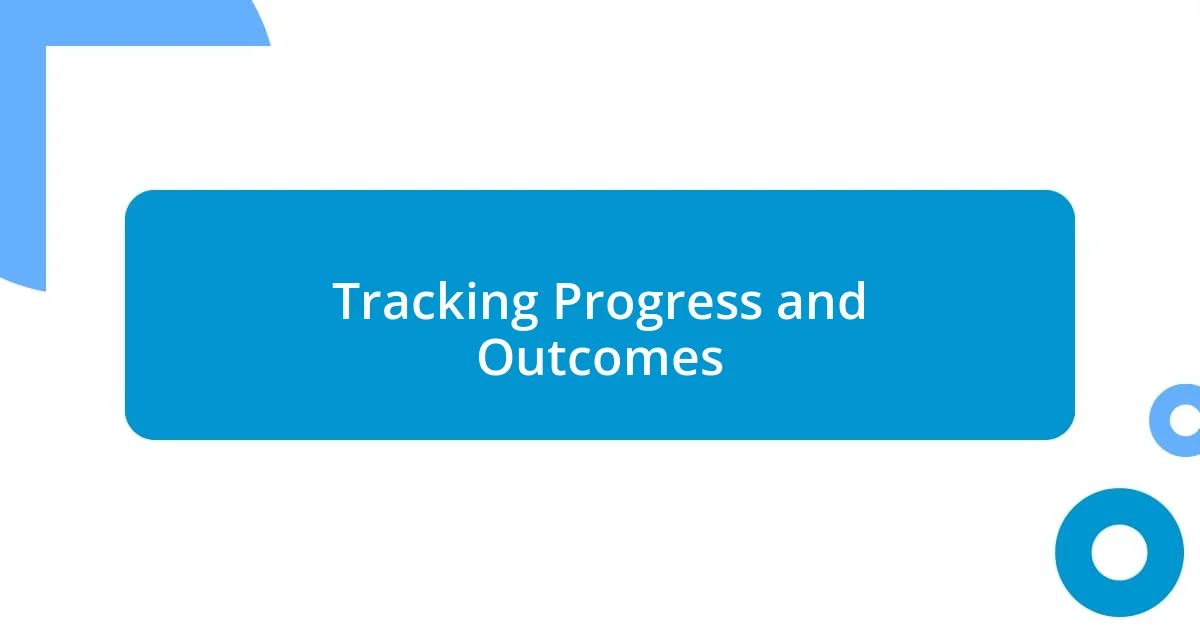
Tracking Progress and Outcomes
Tracking progress in code reviews has been a game changer for my team. I implemented a shared tracking tool where we document every review cycle’s outcomes. At first, I just wanted to keep an eye on the number of reviews completed, but soon I discovered it was essential to analyze the types of comments made and how they evolved. It’s interesting to see patterns emerge, right? Recognizing which areas need more focus not only aids in our growth as developers but also enhances the overall code quality.
Outcomes mean little without reflection, so I’ve started holding periodic reviews of the data we gather. During these sessions, I encourage team members to share their insights on the trends we observe. I was surprised when one teammate mentioned that she didn’t realize how her comments had shifted over time from vague to more precise advice. Hasn’t that happened to you? Analyzing our growth made us feel more accomplished and motivated to keep pushing our boundaries.
Additionally, I advocate for setting measurable goals based on our tracking insights. For instance, after identifying a specific area where we struggled—the quality of comments—we decided to aim for a 20% increase in actionable feedback within a month. Watching my teammates rally around this goal was incredible. I even overheard someone say how much more purposeful their comments felt. It’s powerful to witness that kind of motivation; it makes you wonder how tracking progress could reshape your own team’s efforts.


